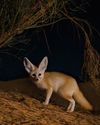How I learned to speak wolf
BBC Wildlife
|June 2025
Deep in Yellowstone's Lamar Valley, George Bumann develops a sense of what wolves' howls can mean

I STOP SHORT OF TAKING MY NEXT STEP. Somewhere amid the squeak-crunch of snow beneath my boots and the footfalls and heavy breathing of our labrador, Hobbes, there is something else. The two of us stand motionless as I pull my wool cap up and away from my ears. I can't help but smile, noticing that both Hobbes and I are tilting our heads the same way, straining for the next sound.
There it is. This time, there is no doubt - it is the distant howl of a wolf. The faint sound is at the very edge of my hearing. Starting low, it reverberates and builds. It is not the vocalisation of a single individual after all, but howls from an entire pack. What I am hearing is the quintessential call of the wild emanating from some unseen corner of the upper Yellowstone River valley.
Anne Fernald, a professor at Standford University who specialises in children's language development, has deliciously referred to sound as “touch at a distance”. This notion strikes a chord with me, pointing to what can connect us with the more-than-human world.
My own explorations into the conversations of wolves began more than 20 years ago in the heart of Yellowstone’s northern range on the spectacular sprawling floor of Lamar Valley, the epicentre of the wolf recovery in the park that began in the mid-1990s. My wife Jenny and I lived in a small cluster of cabins - the only human outpost for several miles. During our first spring in the valley, the matriarch of the Druid Peak wolf pack gave birth to a litter of pups a few hundred metres to the east. We watched spellbound as the pack travelled, hunted, played, fed their young, forded rivers and streams, slept and, yes, howled. One thing was evident from the beginning - one howl was not the same as another. I couldn’t help but wonder, “What are you saying?” Fortunately I was perfectly placed to find out.
Denne historien er fra June 2025-utgaven av BBC Wildlife.
Abonner på Magzter GOLD for å få tilgang til tusenvis av kuraterte premiumhistorier og over 9000 magasiner og aviser.
Allerede abonnent? Logg på
FLERE HISTORIER FRA BBC Wildlife

BBC Wildlife
"I was terrified the elephant would ram us"
African elephant in Kenya
2 mins
January 2026

BBC Wildlife
ALL YOU EVER NEEDED TO KNOW ABOUT THE Fennec fox
THE FENNEC FOX IS THE SMALLEST fox in the world, with a body length that can be as little as 24cm.
3 mins
January 2026

BBC Wildlife
INTO THE PLASTISPHERE
A unique synthetic ecosystem is evolving in our oceans – welcome to the plastisphere
7 mins
January 2026

BBC Wildlife
“More than half of all animal life exists in a parasitic relationship, and all life lives in symbiosis”
Our survival depends on species evolving to live together - but some relationships take dark turns
7 mins
January 2026

BBC Wildlife
Are animals able to dream?
SLEEP IS A MYSTERIOUS THING. FOR A long time, we weren't sure why we do it.
1 mins
January 2026

BBC Wildlife
Does a cuckoo know it's a cuckoo?
ABSURD LITTLE BIRDS ACROSS THE world lay their eggs in the nests of other species, leaving the hapless parents to raise a changeling at the expense of their own offspring.
2 mins
January 2026

BBC Wildlife
Orcas killing young sharks
Juvenile great whites are easy prey for orca pod
1 mins
January 2026

BBC Wildlife
Ocean goes on tour
Acclaimed film touring the UK, backed by live orchestra and choir
1 min
January 2026

BBC Wildlife
Feisty bats hunt like lions
Winged mammals use a 'hang and wait' strategy to take down large prey
1 mins
January 2026

BBC Wildlife
SNAP-CHAT
Richard Birchett on magical merlins, wily coyotes and charging deer
2 mins
January 2026
Listen
Translate
Change font size

